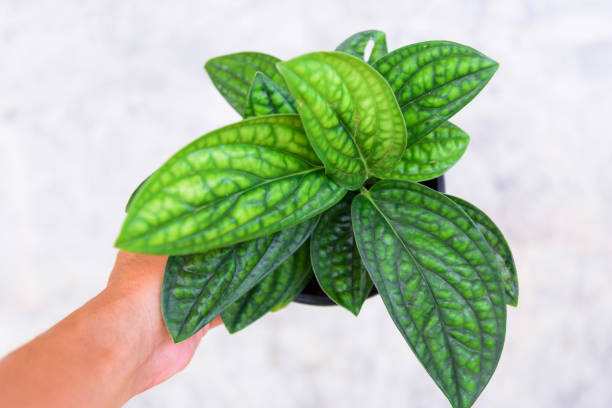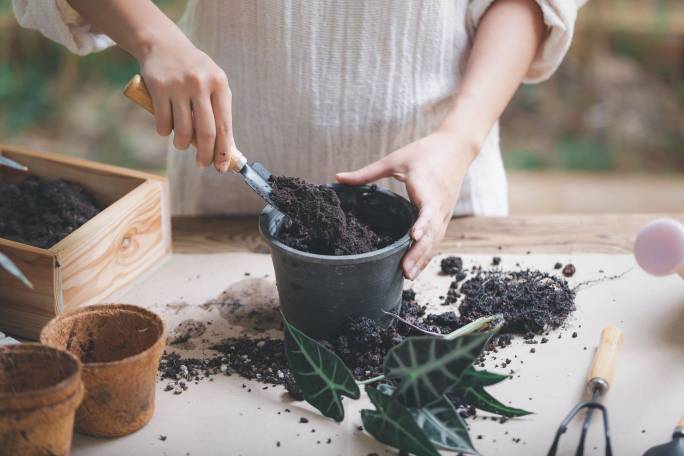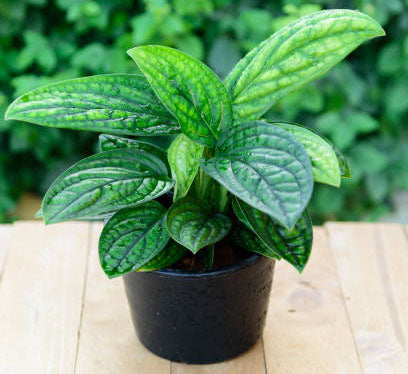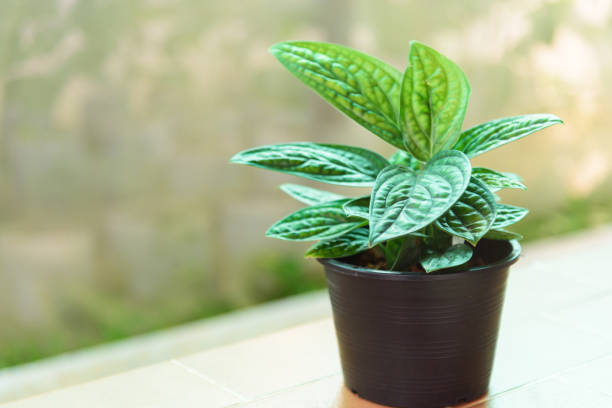
"Monstera Peru" is an easy-care plant that doesn't quite look like its more well-known cousin, Monstera deliciosa – Peru is missing those classic fenestrated leaves – but it's just as visually interesting. This vining plant likes mostly indirect light and is more sensitive to watering than other Monstera plants. It's a great plant for those who tend to be a little forgetful about plant care.
The Monstera genus has become quite a hit in the plant world, with species that are easy to grow and propagate. While many people focus on Monstera deliciosa, a variety that has erect stalks growing out of a clumping root, "monstera Peru" (Monstera karstenianum) is a vining tropical plant with decidedly different-looking leaves. This is an interesting plant for anyone to try growing.
What Is Monstera Peru?

Monstera Peru is the common name of Monstera karstenianum, and as the common name shows, it is native to South America. Some sources say Peru, which gives it its name, but others claim it's a native of Venezuela. This monstera is becoming easier to find but still tends to be uncommon enough that it's the subject of curiosity when people first see it. It doesn't look like the typical image of a monstera.
Monstera Peru has thicker, waxier leaves that look perfect for water storage, and that's what they do. The plant isn't succulent, but you'd be forgiven for thinking it was at first. The leaves don't have the typical openings or fenestrations that you see on other monsteras, and the leaves are very glossy. These are not flat leaves at all, but instead, they have noticeably raised sections in between the leaf veins.
The color is somewhat variable; it's all green, but the areas between veins are lighter while the veins themselves are a darker green. If you hear someone mention variegated monstera Peru, this is what they're talking about.
Monstera Peru Care & Growth

Monstera Peru is a vining plant and needs something to climb up as it grows. You'll usually see a stake or moss pole planted alongside the stem. Fat, oblong leaves position themselves to soak up light, and the plant can grow pretty quickly to between 3 and 12 – yes, 12 – feet. You'll often see its height potential listed as only 6 to 8 feet, though. It's a nice choice for a hanging basket, too.
Monstera Peru Light Requirements

Like other monsteras, monstera Peru prefers indirect light that copies what it would get in a tropical forest. The light there would not necessarily be part-shade, but it would peek through the leaves of other plants and not shine directly on the monstera.
However, one difference with this monstera is that its thicker leaves and extra water storage make it a bit better at dealing with direct sunlight that hits it. You still don't want to place it in the open in the hot afternoon light, but cooler morning sunlight for a short time may not be as much of a problem.
However, limit the direct light it does get. Being less of a problem doesn't necessarily equate to being totally OK for the plant.
How Often to Water Monstera Peru?

This monstera does require water, but you can go a long time between waterings. You definitely need to water it thoroughly when you do, and the plant needs to be in well-draining soil in a pot with drainage holes. But if you let the soil dry a little more than usual, the plant should be OK. This means that if you forget to water it once, it's more likely to survive very well. When it dries out too much, the leaves may start to curl.
Generally, you want to let the top 2 inches of soil become completely dry before the next watering. That's a change from the usual "top 1 inch" rule.
Substrate/Soil

Monstera Peru vines grow up on trees and branches in the wild, and the plant has rather shallow roots. That well-draining soil also needs to hold onto moisture for a time, so you'll need to find a mix that gives you that balance between not being soggy and not letting all the water run through in an hour. Coco coir, perlite, and orchid bark mixed together often work very well. You can find premixed soil blends for the monstera Peru plant if you don't want to do the mixing yourself.
Whether you use a premixed or hand-mixed version, ensure the soil isn't compacted around the plant. That will inhibit oxygen uptake by the plant's roots and contribute to growth problems.
Monstera Peru Temperature & Humidity

Monstera Peru likes moderate temperatures, so aim to keep it in a comfortable setting. Temperatures and humidity levels that you typically find comfortable (assuming you're not a fan of extreme temperatures) should be suitable – so, in the 60s or 70s Fahrenheit. Humidity should be at least 50 percent but no more than 70 percent.
Create a humidity tray for the monstera if your home is usually drier than 50 percent humidity. Place the container that the monstera is in on a tray filled with pebbles and water. As the water evaporates, the vapor will create a little bubble of higher humidity around the monstera.
Another option is to keep the monstera in a place that normally sees more humidity, such as the bathroom, or in a spot that doesn't get as much of a breeze – but you'll need to check the humidity levels there before assuming it will be appropriate for the plant.
Growth

A healthy monstera Peru can grow as much as 12 feet high, so if you're looking for something to wind its way up the wall or around a column, this is a great plant for you. If you want the plant to remain in more compact circumstances, you'll need to trim it regularly.
Monstera Peru Propagation

All that extra growth means more monstera, right? You can propagate monstera Peru in a number of mediums, including soil and water. The process, though, is a bit different from the propagation of other monsteras like deliciosa. You'll have to give monstera Peru more care, and the process may benefit from rooting powder and a terrarium.
Where Can I Find Monstera Peru?

Finding monstera Peru can be an adventure. If you have well-stocked nurseries near you, start there; it's best to get the plant from a place you know offers good-quality greenery.
If the nurseries and garden centers in your area don't have it, you have two options. One is to get a cutting from a friend with a plant. If you know someone who is propagating monstera Peru, see if they'd be willing to give you a cutting.
The other option is to buy online, and surprisingly, some Etsy shops have become well-known sellers. Always check reviews, and read terms and descriptions to be sure you understand what the shop will send you. Look for seller reputation over price because a cheap plant in bad condition isn't going to be a great buy.
How Do You Root a Monstera Peru Cutting in Soil to Propagate It?

Propagating monstera Peru in the soil is not that hard. Choose a stem on the existing plant that already has a few leaf nodes on it. Stems that are at least 8 inches or so in length should have enough. Nodes are the points where leaf stems branch off from the main stem or vine. You can find sections of the vine that have multiple leaves growing along with it.
Sterilize pruning shears or scissors with rubbing alcohol. You can dip the blades in the alcohol or just wet a clean paper towel with the alcohol and rub it along the blades on both sides and the edges.
Snip the stem off below a node. Don't cut the node itself; a clearance of at least a quarter inch is advisable. Cut off leaves that are right by that bottom node.
Before you plant the cutting in soil, let it sit in a warm place for a couple of days until the cut has started to look like it's healing or sealing over. It's not going to disappear, obviously, but you don't want it wet and freshly cut.
Once the end looks OK, place the end in a good potting mix as described previously. You'll want to place a few inches of the stem down in the soil, about half of the stem, if you can. Remove leaves that would otherwise be buried.
Now it's a waiting game. Keep the soil well-watered – moist but not dripping and soggy. This process will go faster in warmer weather, taking about a month.
If you prefer to propagate via water, take that stem cutting, and when it's still fresh – you don't have to wait for it to seal up – drop it in a clean vase with clean distilled water. Use a little rooting powder if you prefer. In about a month, when roots have formed, you can plant them in potting mix.
Where Does Monstera Peru Come From?

Monstera Peru got its name because someone, somewhere, thought the plant came from Peru. It does most likely come from South America, but Venezuela may be its true home. These plants thrive in tropical conditions that you'd find in Venezuela and parts of Southeast Asia.
Monstera Peru vs. Monstera Siltepecana

Monstera siltepecana (silver monstera) is another South-American variety that looks very similar to monstera Peru. However, when M. siltepecana is mature, it can develop those classic Monstera fenestrations or openings in its leaves. Mature monstera Peru fenestration does not occur. M. siltepecana also absolutely has to climb up something. A stake is better than nothing, but these plants like to climb up tall trees, while monstera Peru can hang down out of a basket or trail along with a countertop.
Common Problems With Monstera Peru
Monstera Peru is, luckily, one of those tropical plants that don't suffer from a lot of common pests as long as you keep it healthy. It's stronger and less susceptible to pathogens and pests if you give it the growing conditions that it needs. However, it can show signs of something wrong if conditions aren't met.
Yellow Leaves

One of two things could be going on if you see yellow leaves. The monstera might not be getting enough light; remember that it does need light, even if it's indirect. It's also possible the plant is getting too much water. If you think you haven't been watering it that much, look at the light situation; too little light can lead to too little evaporation and absorption. In other words, light problems can lead to water problems.
Faded Leaves

If the leaves look like they're fading, that's a sign of sun bleaching. Direct light is hitting the plant at some point; it could be when you're not home, so you don't realize it's happening. Look for another spot that provides only indirect light (north and eastern sectors of your home are best), or move the plant away from the light source by a few inches.
Dropping Leaves

Dropping leaves means the plant actually needs more light. The indirect light you give it could be too low. Find a brighter spot; try to keep it out of direct sunlight, but if you have no choice, be sure the plant is at least in the north or east, where sunlight won't be as harsh and won't be direct in the afternoon.
Frequently Asked Questions:
Why Are My Monstera Peru Leaves Curling?
Curling equals dehydration for the plant – give the plant more water, fast. Again, don't make it sit in soggy soil, but if the leaves have been curling, water a little more often and keep the soil moist.
Is Monstera Peru Rare?
Monstera Peru isn't as common in stores as, say, M. deliciosa, but it's a lot easier to find now than in previous years.
Does Monstera Peru Flower?
You can get some flowers from a monstera Peru – you might luck out and see small white flowers in clusters. But this is rare in houseplant monstera Perus; flowering is much more common in the wild.
Conclusion
Monstera Peru is an interesting and bright addition to your home, and its easy care routine makes it a great starter plant. It's not a messy plant, but if you've had leaves drop off or trimmed, remember that the waste can count as green or brown waste for composting. A kitchen countertop unit like Lomi can make disposal of these leaves simple.

